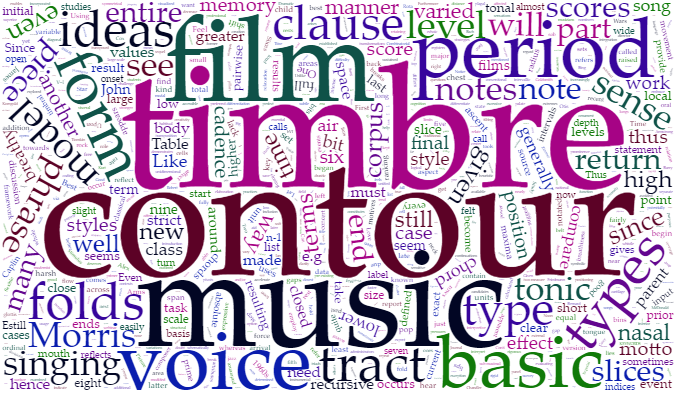Editor’s Message
“It’s spring fever. That is what the name of it is. And when you’ve got it, you want—oh, you don’t quite know what it is you do want, but it just fairly makes your heart ache, you want it so!”
Dear MTO readers,
Although we may not be able to satisfy the object of your nameless yearning, we can at least offer distraction in the form of our new issue, Music Theory Online 22.2 (March 2016), which presents new research on contour theory, timbre, and film music, along with a commentary on the College Music Society’s recommendations for changing the undergraduate music curriculum, which will serve as the basis for a webinar on Monday, June 6. The “manifesto” that set forth these recommendations was the subject of a panel at the 2015 meeting of the Society for Music Theory; the webinar will continue the discussion with presenters from the panel.
We offer a brief visual summary of the current issue’s contents in the form of the following word cloud:

In slightly more detail: Aaron Carter-Ényì proposes a model of contour recursion as a basis for melodic segmentation and computational analysis, Kate Heidemann offers a system for describing vocal timbres based on four aspects of vocal production, Mark Richards adapts the Caplinian model of phrase structure for film-music themes and presents a corpus study of themes from the 1930s to the present, and Jennifer Sterling Snodgrass reflects briefly on the College Music Society manifesto. For the webinar on June 6, she will be joined by Juan Chattah, Melissa Hoag, Jena Root, Elizabeth Sayrs, and Matthew Shaftel.
Thanks to the efforts of our excellent reviews editors Kyle Adams and Heather Platt, we also present three book reviews: Robin Attas considers the questions raised in Ron Moy’s Authorship Roles in Popular Music, Trevor de Clercq assesses the methodologies and analyses in Song Interpretation in 21st-Century Pop Music by von Appen et al., and Patrick McCreless surveys the essays reprinted in Thomas Christensen’s The Work of Music Theory and contemplates their larger context.
We are pleased to report that work on our retrofitting project—updating text and media in previous journal issues to modern formats—is nearing completion. Thanks for this go to managing editor Brent Yorgason for his skillful work behind the scenes, to the members of the editorial board, and to the editorial assistants. In addition, we are deeply indebted to the many referees who provide lengthy, detailed, and well thought-out reviews containing excellent advice for our authors. This reflects an impressive and commendable commitment to mentoring new scholarship in the discipline, as well as helping to disseminate it.
We encourage new and creative submissions to MTO. Although we are especially well suited for the publication of articles that incorporate recordings, videos, and other media, we also welcome text submissions in a variety of formats, including full-length articles, shorter essays and commentaries, conference reports, and entire special volumes. Commentaries in response to this issue’s articles, as well as announcements for our job listings and dissertation index, may be submitted to the Editor for publication in the next issue. Please refer to our submission guidelines.
All MTO volumes dating back to our first issue in 1993 can be accessed from the contents page at http://www.mtosmt.org/issues/issues.html. Thank you, as always, for your support of MTO—a Journal of the Society for Music Theory.
